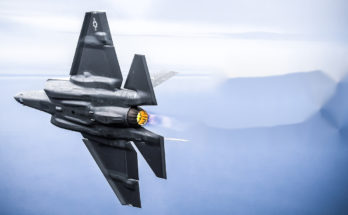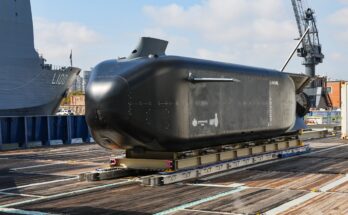
The FY22 budget cuts one DDG 51 class destroyer. Pictured here is the USS Paul Ignatius (DDG 117). Source: Huntington Ingalls Industries
President Joe Biden has not adopted a naval expansion proposed by the previous administration, but the future of the Navy fleet remains uncertain because a new long-term shipbuilding plan has not been finalized.
The Navy’s FY22 budget request, released at the end of May, included $22.6 billion for shipbuilding and conversion, $698 million less than the FY21 enacted level. Last year’s FY21 request sought $19.9 billion for ships, but Congress added $3.4 billion during the FY21 budget markup process. The FY22 topline figure includes $18.1 billion for construction of new ships, with the remainder of funding supporting items like aircraft carrier refueling and procuring landing craft. Despite the drop from FY21, the shipbuilding & conversion account is nearly $1.5 billion more than projected in the previous year’s budget. There is an important caveat to this comparison, however, because the Navy released a proposed long-term shipbuilding plan in the final weeks of the Trump administration that would have significantly increased warship construction over the coming years. That plan was known as Battle Force 2045.
That plan called for increasing the battle force fleet to 403 manned ships, up from the previous goal of 355 ships. Added onto that would be 143 unmanned platforms, bringing the total to 546 ships. The expansion would have required a significant increase in Navy funding. Specifically, the draft plan called for $22.8 billion for new ship construction alone in FY22, compared to $18.1 billion found in the actual FY22 request (again, those figures don’t include nuclear refueling or acquisition smaller craft).
The FY22 request includes eight battle force ships: two Virginia class submarines, one DDG 51 class destroyer, one Constellation class frigate, one T-AO 205 class oiler, two T-ATS salvage and towing vessels, and one T-AGOS ocean surveillance ship. Compared to projections from the previous year’s budget, the request cuts one destroyer but adds one oiler and one T-ATS. When questioned about the loss of a destroyer, Navy officials said it was a necessary sacrifice needed because the service was prioritizing readiness and training over growing the force. However, the Navy included a second destroyer in its unfunded priorities list, and Congress may very well add the ship during the budget markup process. If you then compare the Navy’s latest budget to the proposed shipbuilding plan from December, the FY22 request falls short by one destroyer, one LHA amphibious warship, and two T-EPF expeditionary fast transports.
The new administration is still reviewing Navy broader shipbuilding requirements. A new long-range shipbuilding plan was released in June shortly after the FY22 budget request. The document includes a range of potential future fleet sizes, but an exact goal may not materialize until the submission of the FY23 budget request. The FY22 shipbuilding plan identifies a range of between 321 and 372 manned battle force ships, plus between 77 and 140 unmanned vessels, providing a total range of between 398 and 512 ships.
The shipbuilding plan still includes a new Light Amphibious Warship (LAW) for the Marine Corps, but this asset comes at the cost of larger amphibious ships. The Marines had a previous requirement for 38 large amphibious ships, enough to support two Marine expeditionary brigades consisting of 17 ships each (with a few additional ships to allow for maintenance downtime). The FY22 budget plan recommends between 24 and 28 large amphibious warships, a notable decrease from the previous requirement. In 2019, the Marine Corps started to distance itself from the 38-ship warfighting framework, noting that different approaches may be required to address the threats against larger ships in contested environments. Those concerns, as well as a shift towards more distributed amphibious operations, resulted in the creation of the LAW requirement. The previous administration’s proposed naval expansion would have effectively added LAW onto the existing large amphibious ship goal, whereas the FY22 plan sacrifices a few of the larger ships in order to free up resources for the smaller LAW.
The FY22 long-range shipbuilding plan, which was truncated due to the change in administration, calls for between nine and 11 aircraft carriers (the current requirement is 11). The large surface combatant fleet would drop from 91 ships today to between 63-65 ships, accomplished primarily through retiring the Ticonderoga class cruisers. The Battle Force 2045 plan called for 74 large surface combatants. Battle Force 2045 would have significantly expanded the small surface combatant fleet to 66 ships, but the FY22 plan requires between 40-45 small surface combatants, comprising he Constellation class frigate and Littoral Combat Ship. Of note, the Navy also wants to retire four LCS – hull numbers 3, 4, 7, and 9. The service already received approval to decommission the first two ships in the class, LCS 1 and 2. The second two ships, LCS 3 and 4, would require modifications to remain in the fleet, and the Navy doesn’t have mission packages for those ships. Meanwhile, LCS 7 and 9 suffered major problems with their propulsion system, and budget documents indicate the Pentagon doesn’t want to invest “scarce maintenance funding” to repair the ships.
The attack submarine fleet will continue to grow, according to the Biden administration’s initial plans. The latest shipbuilding strategy calls for up to 72 submarines, which would match the Battle Force 2045 plan. The current strategy also includes the planned 12 Columbia class submarines. The 2018 Nuclear Posture Review said that 12 ballistic missile subs is the minimum goal, suggesting additional subs could be added to the program, but the Biden administration will review that position. The new administration’s plans will become clearer when a complete shipbuilding plan is released alongside the FY23 budget request.
PB22 SHIPBUILDING PLAN JUNE 2021_FINAL-1Forecast International’s U.S. Defense Budget Forecast is a streamlined database providing fast and easy access to the Pentagon’s entire acquisition budget. The product features new sorting and data visualization options, and presents the entire FYDP through an online interface with downloadable Excel spreadsheets. This is the go-to service for anyone familiar with the grind of wading through the massive DoD budget. Pricing begins at $2,295, with discounted full-library subscriptions available. Click here to learn more.
As editor of International Military Markets, North America, Shaun has cultivated a deep understanding of the vast defense markets in the United States and Canada. Shaun's perspective on defense procurement and budget issues has been cited in a variety of defense periodicals, including Defense News and National Defense Magazine. Further, Shaun played an integral role in the development of Forecast International's U.S. Defense Budget Forecast product, which offers an unprecedented level of insight into the Pentagon's acquisition budget. In addition to providing original analytical content for the U.S. Defense Budget Forecast, Shaun oversees an internal defense budget forecasting process involving Forecast International's team of skilled systems analysts following release of the DoD's annual budget request. Shaun is also in charge of managing Forecast International's Weapons Inventory database.




